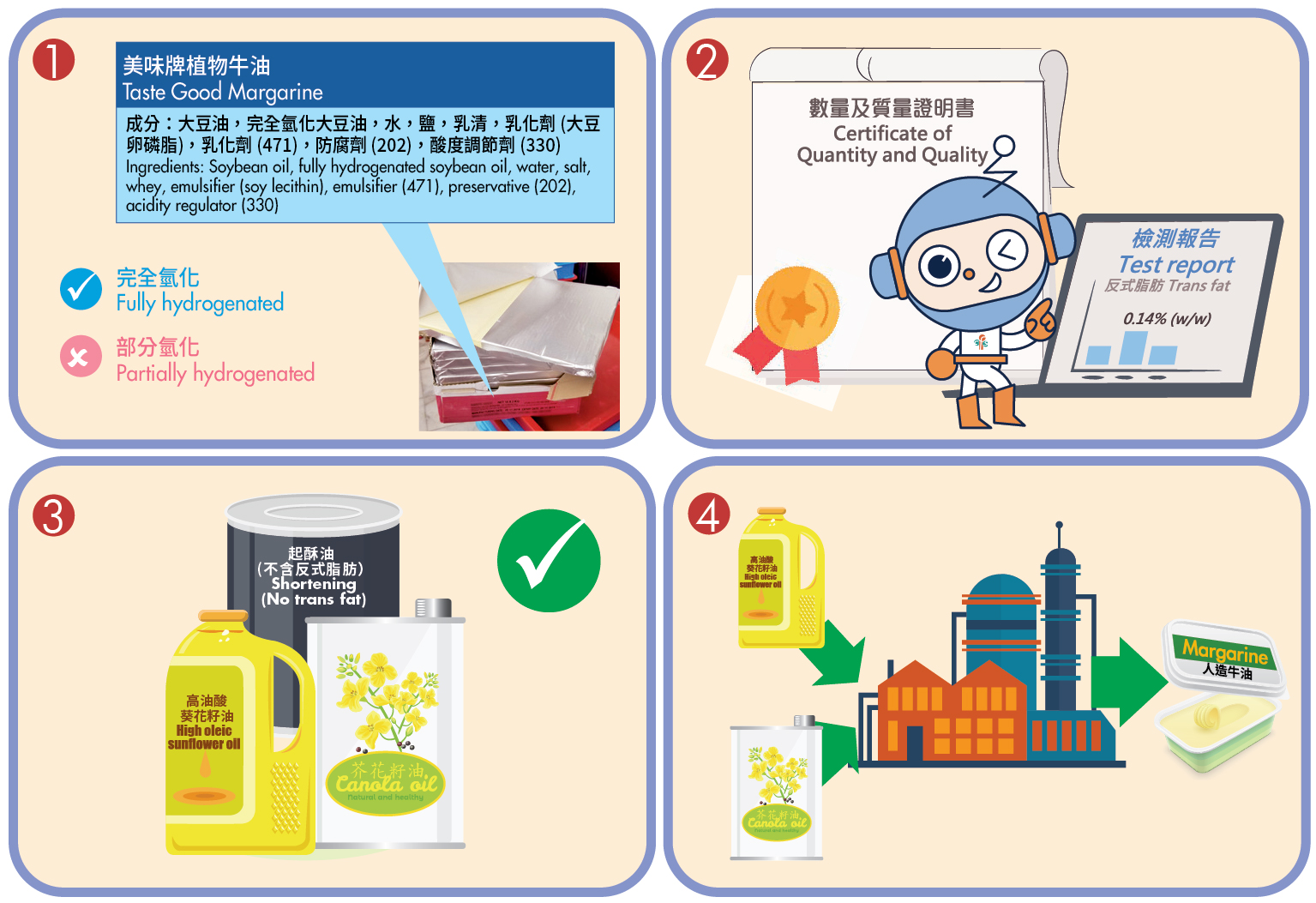
Food Safety Focus (175th Issue, February 2021) – Food Safety Platform
Cracking the Codes of Eliminating Partially Hydrogenated Oils (PHOs) in Food
Reported by Dr. Violette LIN, Scientific Officer,
Risk Assessment Section, Centre for Food Safety
For long, partially hydrogenated oils (PHOs) have been used for producing margarines, spreads, vegetable shortenings and emulsifiers, as well as for frying foods and acting as ingredients of many foods, such as bread fillings, cakes and puff pastries in bakery products. However, PHOs are also notorious for being the main culprit of industrially-produced trans fatty acids (IP-TFAs) that cause harm to heart health. This poses a question: How do we get rid of PHOs and IP-TFAs in our diet? This article will decipher the terminologies related to PHOs and reveal the tricks for consumers and traders to find foods free from PHOs.
PHOs: the Root of IP-TFAs
Vegetable oils undergo hydrogenation to alter the texture, stability and shelf life of the final product. Incomplete hydrogenation of oils produces semi-solid or solid PHOs, whereas complete hydrogenation produces a waxy fat, fully hydrogenated oil at room temperature. The former process can result in large amounts of IP-TFAs, ranging from 25% to 50% of the total fatty acids.
Code One: PHOs can hide in many foods. To avoid manufacturing foods with PHO-containing ingredients, traders can ask suppliers to provide PHO-free ingredients or use the World Health Organization (WHO)'s recommended healthier replacers.

Figure 2: Traders can identify PHOs in food products by (1) reading the ingredient list or (2) obtaining product specifications, and replace PHOs ingredients with healthier alternatives, such as (3) using oils high in unsaturated fats and (4) procuring specific oil/fat products with industrial processes other than hydrogenation.
Avoiding PHOs or IP-TFAs? Read the TFA level
TFAs are unsaturated fatty acids consisting of at least one trans double bond. Most TFAs, amounting to about 50% of a product's fat content, are synthetic fats used in the manufacture of foods, i.e. IP-TFAs. TFAs will doubly jeopardise our heart's health by lowering the 'good' cholesterol and increasing the 'bad' cholesterol in our blood, thus increasing the risk of coronary heart diseases.
Code Two: On a nutrition label, high TFAs of total fat indicate a high chance that IP-TFAs or PHOs have been added to the food especially for food made with vegetable oils. To avoid foods with ingredients containing PHOs, choose or procure foods with low or no TFAs.
Healthier Replacers are Around the Corner
Food manufacturers use oils and fats for different reasons. They can be used as a heat transfer medium, release agent, lubricant and moisture barrier. They can also be used to create body and texture for enhancing mouthfeel and melt, as a flavour carrier and release, for oil binding, and for creaming and lamination. After ascertaining the functions and sources of oils and fats in the food products, traders can replace those ingredients containing PHOs by making reference to the Guidance to Replace Industrially-produced Trans Fats in Food.
The healthier replacers shall have the lowest saturated fats and highest unsaturated fats. Their contents of saturated fats should also be less than the sum of saturated fats and trans fats in the PHO-containing products being in use. When fats are only needed as a heat transfer medium, release agent or lubricant (e.g. for frying), use liquid oils that do not oxidise quickly, such as high oleic canola oil. For other products that need 'body' or other functionalities of saturated fats, combinations of technologies (e.g. blending) are well suited to formulate products.
Code Three: PHOs are not produced by local oil/fat manufacturers as they require specific industrial processes and many oil importers and traders in catering and baking industries have been importing PHO-free ingredients for manufacturing their foods. If product reformulation is required, traders can check with suppliers for the ingredient details of the products according to needs.
PHOs can be eliminated from our diet with tripartite efforts of consumers, traders and the government. While consumers choose food low in TFAs and manufacturers replace PHOs in foods/reformulate foods, to effectively eliminate the presence of PHOs from the source of the food supply chain, we solicit your support on the Proposed Amendments to the Harmful Substances in Food Regulations (Cap. 132AF). This proposal regards PHOs as prohibited substances in food and stipulates the labelling requirement for hydrogenated oils. The three-month public consultation will end on 15 March 2021.


